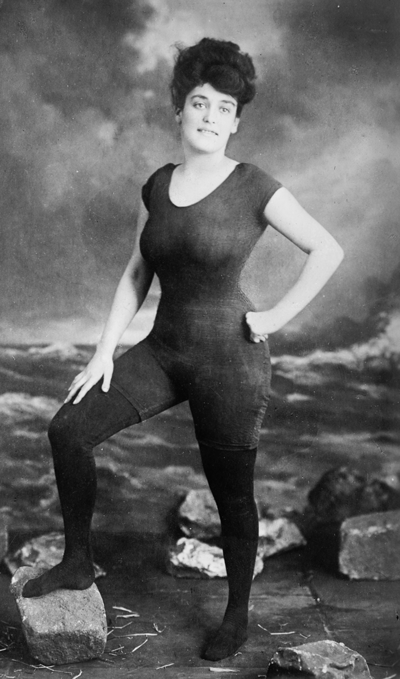Fashion is a fickle thing, constantly changing: hemlines rise and fall, fabrics gain and lose favor, colors and patterns cycle through popularity. Each era has its own definitive style which encompasses not only the aesthetic, but is also reflective of the cultural norms, moral attitudes, and even available technologies of the time. The corsets and crinolines of Victorian times are a far cry from the miniskirts and platform shoes of the 1960s. Most don’t think of the swimsuit as a culturally significant fashion item, but it has a long and colorful history going back thousands of years with an evolution that might surprise you. And though we can’t be certain, one thing (probably) hasn’t changed at all—the agony and ecstasy of finding the perfect swimsuit.
In the beginning…
Public bathing was very popular in ancient Greece and Rome. Scholars believe that men and women of the upper class wore swimsuits in the bath houses. The earliest known image of women wearing swimsuits is from the early 4th century. “The Bikini Girls” mosaic decorated the floor of a Roman bath at the Villa Roma de Casale near Piazza Armerina, Sicily. The women are shown exercising and competing in various athletic events clad in what looks much like a modern bikini. The only exercise that didn’t require a swimsuit at the time was swimming. Romans chose to do that in the nude.
Fashion and Beyond….
From Princess Leia’s gold bikini in Return of the Jedi to the high cut red one-pieces of Baywatch, swimsuits have made a big splash on the big (and small) screens. Farrah Fawcett, Demi Moore, Kate Upton, and countless Bond girls have their place in swimsuit history along with their iconic swimsuits. The evolution of the swimsuit is just as drastic on the men’s side as well. In fact, the bare chests that are so common today were frowned upon until 1933. Even then, men’s “topless” swimming trunks were not widely accepted until the endorsement of Olympic swimmer, Johnny Weismuller.
All the advances in fabric technology and aerodynamics haven’t just been in service of fashion. Specialized swimsuits are a critical tool for today’s athletes. Competitive swimmers and divers wear suits specially designed to reduce friction and drag in the water and protect the skin from abrasions. Some of the newly-engineered suits are so effective that non-textile suits were formally banned from competitive events in 2010. The policy was implemented because officials believed certain suits had crossed the line from performance assisting to performance enhancing.
There is a rich history that lies between the first bathing suit in Rome and the iconic swimsuits of modern day.







Join the discussion